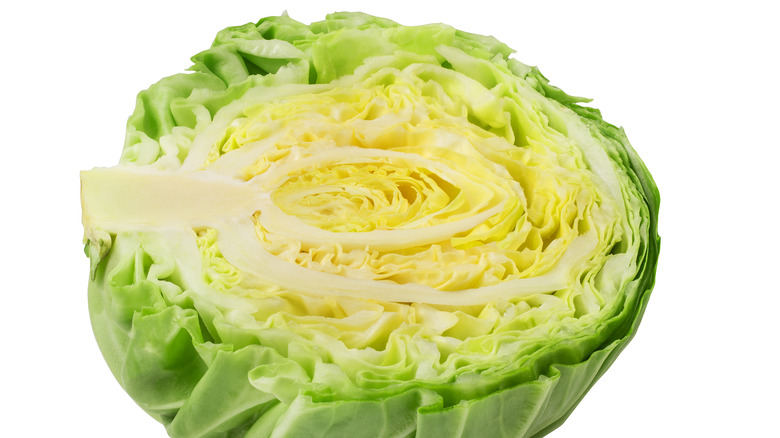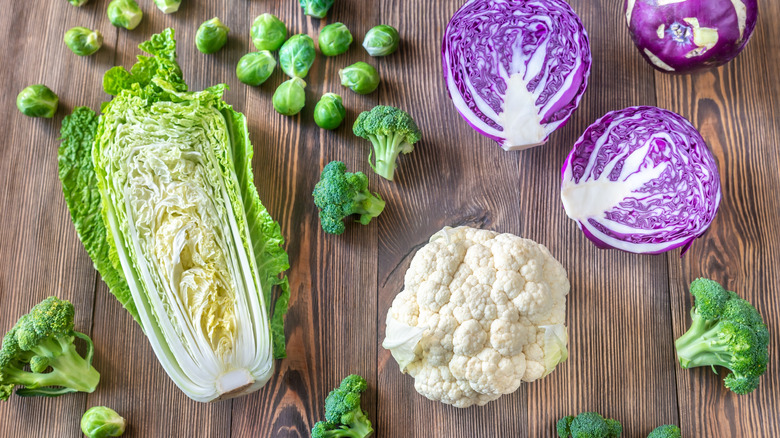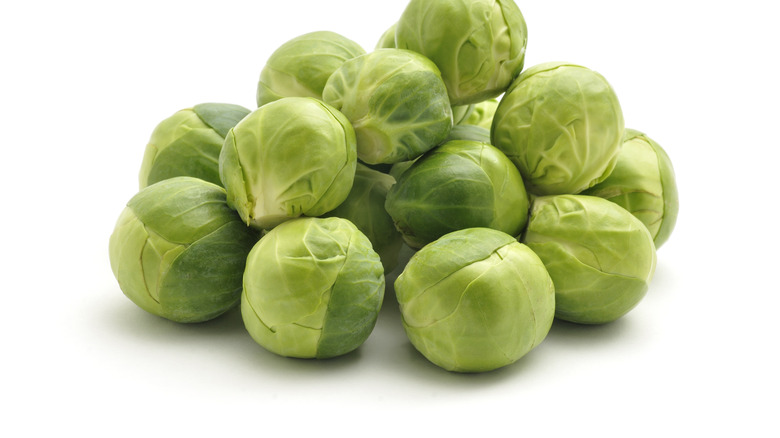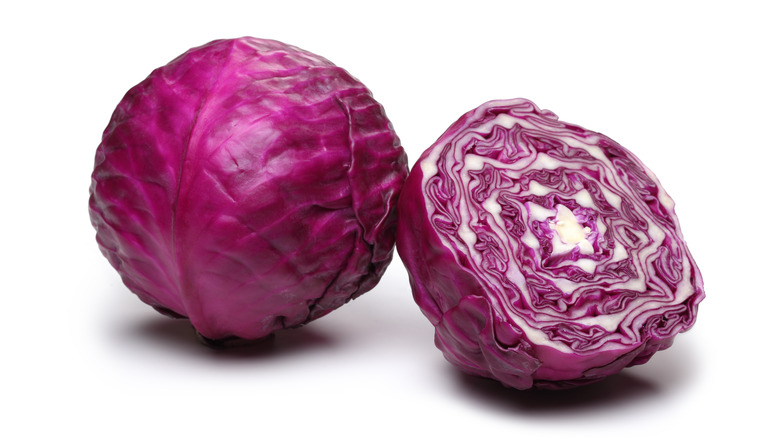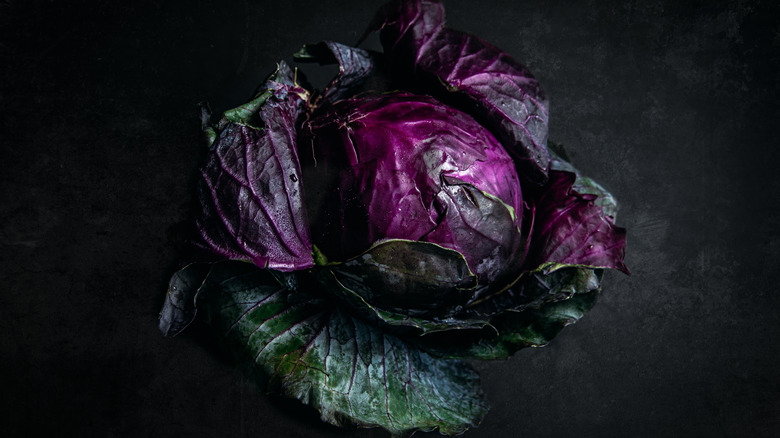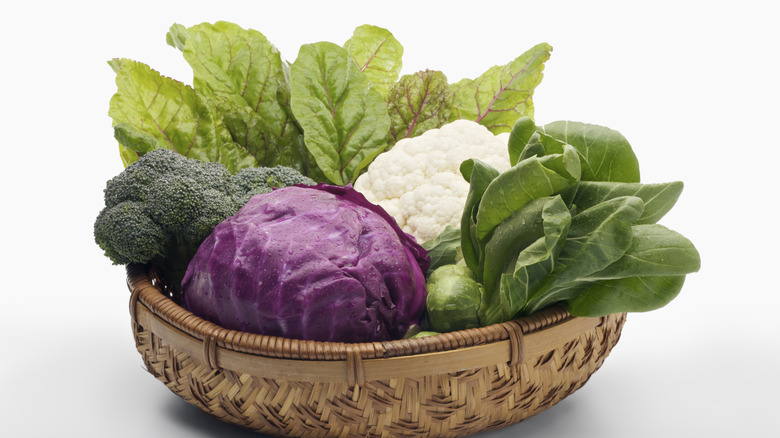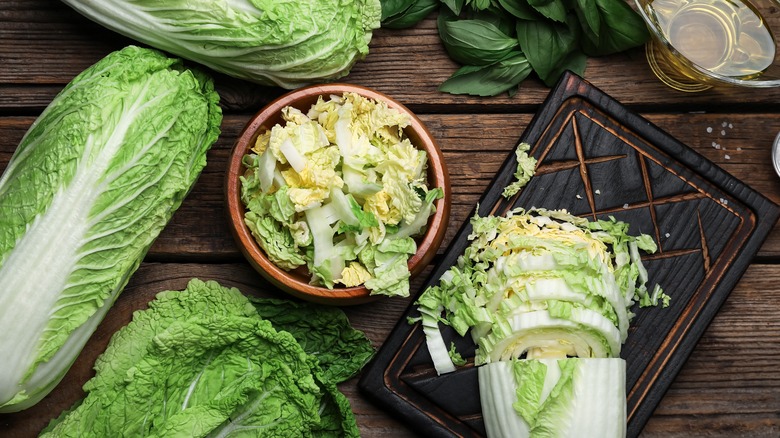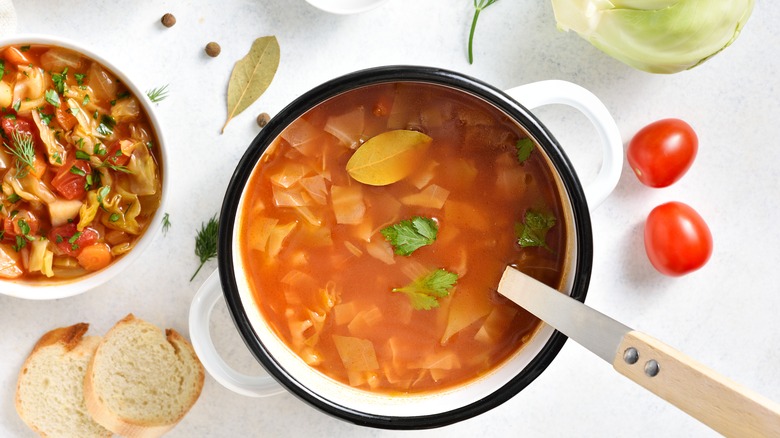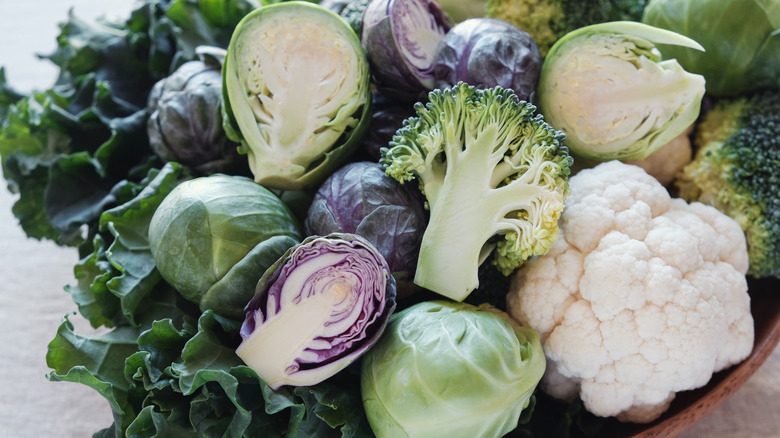False Facts About Cabbage You Thought Were True
At the heart of many an ancient myth or legend sits the humble cabbage. In Egypt, it was venerated as a god, and the Ionians swore their most solemn, sacred promises on a cabbage stalk. Roman and Greek myths seem to associate cabbages with saltwater, assigning them origin stories that see them proliferating from either the sweat or tears of the gods. In France, meanwhile, parents who don't feel quite ready to talk about the birds and the bees with their kids may claim babies appear fully formed in cabbage patches.
But while these myths are easily busted, some other more common myths, legends, or simply erroneous facts are still floating around concerning this humble crucifer. From hangover cures to horrendous odors, from dubious claims of unique weight loss properties to a ho-hum flavor that pales in comparison to those of other more exciting, enticing vegetables, here are the false facts about cabbage you thought were true — and the ones it's high time to stop believing.
All cabbage comes in a round head
When you think of cabbages, you might think first of a green or purple vegetable in a tight, round sphere, the sort of shape that almost certainly gave rise to a particularly old-school playground insult, "cabbage head." But this is far from the only form the vegetable can grow. Hispi cabbage grows in a cone, while napa cabbage boasts an oblong shape whose leaves feather out slightly, looking halfway between a lettuce and a more typical head of cabbage. Meanwhile, everyone's favorite superfood, kale, is also a cabbage, which is far looser and leafier than many of its cousins, looking more like chard or spinach than a pale green head of cabbage.
If you're willing to extend the definition of cabbage to any member of the brassica family, cabbages may also be said to grow in florets, like broccoli and cauliflower, the latter of which, according to Encyclopedia Britannica, is a "highly modified form of cabbage," but a cabbage nonetheless. Indeed, the ancestors of more domestic cabbages bear a similar resemblance to little flowers, as evidenced by the form of related plants like mustard, which, while a member of the brassica family, barely resembles a cabbage at all.
Brussels sprouts are just baby cabbages
Given their appearance, it's perhaps no surprise that Brussels sprouts are also members of the cabbage family. But despite what you might expect from looking at them, they're not just baby cabbages.
The difference between cabbages and Brussels sprouts is evident to anyone who's ever wandered a cabbage patch: While cabbages grow in one large head close to the ground, Brussels sprouts grow as little buds along a tall, fibrous stalk. As a result, Brussels sprouts take longer to harvest, but the extra work is well worth it. Brussels sprouts boast a milder, sweeter, nuttier flavor than many larger cabbages and are even richer in several key nutrients than their heftier cousins. And despite their longtime unpopularity, these days, Brussels sprouts are a total crowd-pleaser, especially when roasted to bring out their lovely caramelized sweetness or combined with smoky bacon to make them even richer and more flavorful.
Green cabbage is just under ripe purple cabbage
While in the case of some members of the produce aisle, a green color is a sign of under-ripeness (think bananas), such is not the case for green cabbage. Indeed, purple cabbage is its own thing, a wholly different variety, albeit one whose distinct color doesn't offer much by way of a flavor difference. Where purple cabbage truly stands out, however, is in its drastically different nutritional profile. Richer in certain beneficial compounds than its green cousin, purple cabbage possesses the power to lower inflammation and may even reduce the risk of cancer.
Red or purple cabbage's superpowers stem in large part from its anthocyanin load. These flavonoids aren't just responsible for its beautiful hue. They have also been proven to have the potential to lower blood pressure and heart disease risk as well as diminish the likelihood of heart attacks.
Of course, purple cabbage isn't just great for its health benefits. It's also gorgeous on the plate, whether raw, as in a cabbage salad, slaw, roasted, or pickled.
Cabbage is super stinky
Cabbage has a pretty odiferous rep, but the reality is that cabbage doesn't need to be stinky. It all comes down to two factors: its freshness and how you cook it. Cabbage's occasional pungency stems from its richness in sulfur compounds, which are part of what makes it such a nutritional powerhouse. Not only are these compounds antioxidants, but they also help us make essential amino acids, hormones, and enzymes. Cooking or fermenting transforms these compounds, leading them to emit the stinky smell so many associate with cabbage.
If raw cabbage is particularly pungent, this is not a time to hold your nose and get over it. On the contrary, it might be a sign it's no longer fresh and has begun fermenting. But there's no getting around it: Cooking fresh cabbage will indeed make it stinkier, and the more overcooked it is, the smellier it will become.
There are a few ways you can get around this. Consider roasting cabbage, which doesn't just bring out its lovely caramelized sweetness but also keeps its aromas mainly trapped in the oven. Or consider consuming cabbage raw, as in coleslaw or cabbage salad. If there's no getting around steaming or boiling it, you can cut down on the stink factor by using stainless or enamel, which won't react as strongly with the sulfur compounds in the cabbage as aluminum. And adding ingredients like bay leaves or white vinegar will also help keep the stink at bay.
Eating cabbage gives you flatulence
Cabbage is very rich in fiber, and much like other fiber-rich foods, it can contribute to bloating and flatulence. But that's not the only reason eating too much cabbage makes you an unpopular guest at a dinner party. Cabbage's natural richness in healthy sulfurous compounds means the subsequent wind can be pretty stinky. That said, eating cabbage doesn't necessarily need to make you farty. Cooking or fermenting the vegetable can help naturally reduce the sulfur content of the veggie and soften the fiber, rendering it less likely to make you gassy.
This isn't the only way you can help ensure cabbage earns its right at the dinner party table. Adding certain herbs and spices, like bay, dill, turmeric, or ginger, can counteract (or at the very least diminish) cabbage's natural predilection for imparting biliousness. Not only will these flavoring agents cut down on digestive discomfort, but as a bonus, they'll also add loads of flavor to the veggie. Consider cooking cabbage in a turmeric, ginger, and bay-spiked cabbage curry or adding dill to your cabbage rolls for a delicious dish far more pleasant to serve to your guests. (And something you won't regret serving to your spouse.)
Cabbage is always bitter
There's no getting around it: Cabbage does have a bitter edge to it that, especially when eaten raw, can be off-putting for some. But its bitterness can be tempered depending on how you prepare and cook it. Roasting cabbage or frying it brings out its natural sweetness, diminishing some of its bitter character, while pairing it with lemony dressings, sautéeing it and stuffing it into buttery pastry, or caramelizing it with loads of smoky bacon fat distracts from its natural bitterness, ultimately overpowering any unpleasant flavors.
For Yotam Ottolenghi, acidity and fat are your biggest allies in tempering these bitter notes.
"Acidity and fat — in this case lemon juice and butter — aren't there quite to balance the bitterness, but more to transform it from a liability to an asset," he writes in introducing his cabbage roll with walnut recipe for the New York Times Magazine. "Think of a great bar of chocolate: Beyond sugar, it's often these two elements that make it deliciously rich and complex."
Ottolenghi also adds spices — cinnamon and allspice, to be exact — to add even more balance and highlight the sweetness that is also already present in the vegetable. And if that's not quite enough to take the edge off, he notes that certain cabbage varieties naturally boast a less bitter character, like savoy cabbage, with its pretty ruffled leaves.
Cabbage is healthy to consume without moderation
Whether red or green, cabbage is super good for you...but that doesn't mean you can consume as much of it as you like. Not only would that much cabbage likely have detrimental effects on your digestive system, contributing to an uptick in that rumored flatulence, not to mention diarrhea, but research has shown that consuming too much cabbage can lead to a toxic level of certain chemicals like goitrin and thiocyanates, which may lead to dermatological side effects, among others.
While eating too much cabbage is never a great idea, overindulgence is particularly detrimental for some people with certain pre-existing conditions. Consuming cruciferous vegetables like cabbage can interfere with how the thyroid gland uses iodine, and those with hypothyroidism may find that thyroid hormone levels drop even more significantly if they eat too much of it. Those taking certain anticoagulants, meanwhile, may find cabbage overconsumption means medications aren't working as they should due to interactions with the vitamin K naturally present in the vegetable, and for nursing mothers, cabbage can lead to colic in babies. Check with your doctor before adding too much cabbage to your diet.
Cabbage is cheap
Cabbage's rep is definitely that of a cheap vegetable, and it's not for nothing that it features so heavily in peasant recipes like French chou farci, a dish of cabbage stuffed with a savory meat filling, or Tuscan acquacotta, a simple soup whose name — cooked water — does not belie its deliciousness. But cabbage isn't necessarily as cheap as its rep would have it, especially as different varieties may be priced differently according to demand and growing requirements. The price for kale notably skyrocketed at the height of the leafy green's popularity among superfood fans, and these days, it's napa cabbage's turn to price itself out of peasant food fare.
Napa is indeed one variety of cabbage whose relative difficulty of cultivation, not to mention a recent uptick in popularity following a surge in all things Korean food — including kimchi — has led it to be priced slightly higher than other members of the category. But of late, its price has soared even higher, notably in South Korea, following a lackluster harvest. Napa cabbage recently saw its highest price in a decade, contributing to a kimchi shortage.
EU regulations have 26,911 words about the sale of cabbage
In the days leading up to Brexit, one particularly peculiar cabbage-related myth began surfacing on social media, claiming that EU regulations had over 20,000 words dedicated to the sale of cabbage alone. That the ridiculous factoid is untrue may not be surprising — but what is is that it's a rumor that predates Brexit by nearly a century. The very notion that government regulations would have so much to say about cruciferous veggies apparently dates back to World War II America, when a government memo controlling the price of cabbage seeds (and counting, to be fair, just 2,600 words) contributed to a rumor that, in increasing the number of words more than tenfold, became shorthand for unwieldy federal price controls. The rumor jumped the pond, as it were, in the '40s and has been frequently cited by those in favor of smaller government ever since.
The actual European regulations on the size and labeling of cabbage, for what it's worth, amounted to just under 2,000 words in 2006 before being repealed entirely in 2009. These days, while words governing the marketing of produce amount to 263 words and 32,000 words regulate growing farm produce in general, cabbage is singled out nowhere, meaning the words related to cabbage in EU regulations is a grand total of zero.
Cabbage cures hangovers
Rumored hangover cures around the world run the gamut from raw egg to rabbit dung tea, but cabbage appears more than once, touted as a remedy for excessive drinking since antiquity, from Greece to Rome to Egypt. Most claim this misconception hails from an ancient Greek myth, whereby King Lycurgus of Thrace would have driven Dionysus from his land, angering the god of wine, who cursed the king with temporary insanity. Beset by anger, the king set out to destroy any grapevines he saw, but his madness led him to accidentally kill his own son in the process. The tears he cried were ostensibly the world's first cabbages, leading to an ancient Greek belief that cabbage and wine were natural enemies — thus, cabbage could deter the after-effects of over-imbibing.
The reality, according to the National Institute on Alcohol Abuse and Alcoholism, is that cabbage boasts no natural hangover preventive properties — and nor, for that matter, do any of these other remedies. The only cure for a hangover is time.
Cabbage has unique weight loss properties
The so-called "cabbage soup diet" is one of the most unfortunate weight-loss trends. As its name suggests, the diet involves eating large quantities of cabbage soup, the result of which is supposed to be a loss of up to 10 pounds a week.
While the cabbage soup diet certainly can lead to weight loss, it's not the healthiest or most sustainable way to drop a few, and the fact that it does work has nothing to do with any weight loss properties innate or unique to cabbage. (Despite what some myths may say, no food has magical fat-burning capabilities.) If the diet works, it's because the soup recipe at its core is naturally low in calories, and any low-calorie diet will ultimately contribute to weight loss. Cabbage's richness in fiber may contribute to feelings of fullness that may make it easier to stay the course, but once the diet is over, you'll likely regain all that weight. Moreover, given the low protein content of the core ingredients in the soup, it's likely that you'll lose muscle mass at the same time.
Cabbage is boring
Given how inexpensive and omnipresent cabbage is on tables worldwide, it could be easy to deem it boring. But despite the debunking of many of the colorful and enticing myths that might have lent a bit of mystique to this vegetable, let's be clear: Even devoid of its legends, cabbage is anything but boring.
Cabbage is delicious, nutritious, and beautiful. It is as easy to enjoy raw as cooked, not to mention fermented, as it so often is around the world in recipes ranging from kimchi to sauerkraut. Indeed, its innate versatility has contributed to a wealth of distinct cabbage recipes around the world. Some pair it with sausage or corned beef; others float it in soup or coax out its soft sweetness by sautéeing it in butter or lard before encasing it in flaky pastry. Cabbage can be shredded or chopped, marinated or dressed, roasted or fried. Its leaves make pretty parcels to stuff with seasoned meat, while whole slices can make an enticing, plant-based stand-in for steak, showing off its many layers. Boring? If anything, cabbage is nearly impossible to tire of.
